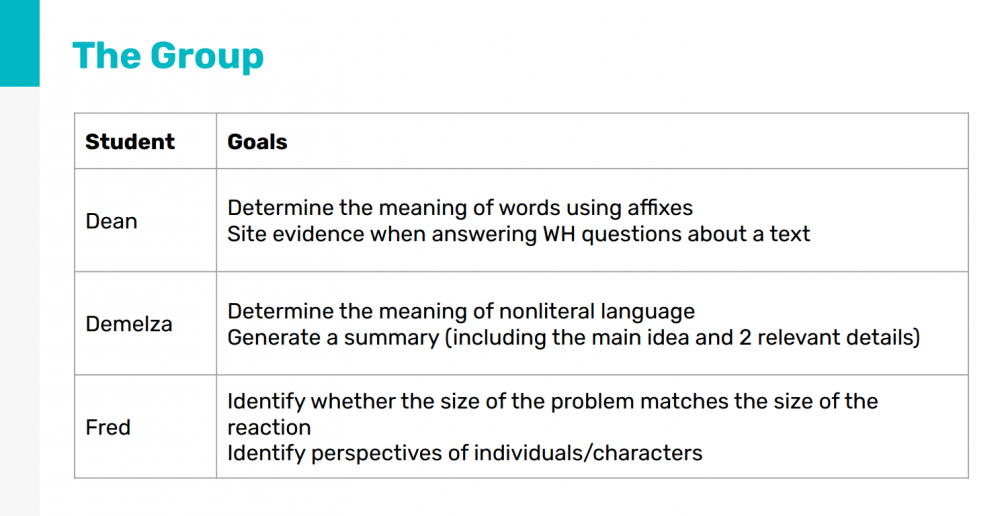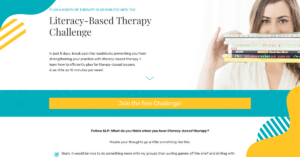Listen on Apple Podcasts Listen on Spotify
Today’s Topic: Literacy-based therapy plans for secondary students!
In this week’s episode we’re going to review plans for our secondary students. Dean, Demelza and Fred are working on the following goals:

When we move from working with younger students to more mature learners, we tend to shift from focusing on fiction to incorporating non-fiction texts.
Fictional stories are great for story grammar and narrative skills, which are important to target — especially when our kiddos need to recount past events, or explain something that happened on the playground earlier that day.
Without foundational narrative skills, it can be tough to connect with peers.
As they get older, students are introduced to more expository texts and more complex syntax. It’s important that they’re able to pull information from this type of text, learn from it, and integrate it into their assignments, essays, tests and more; it’s a very functional activity, and what we’re talking about in this week’s episode.
We’re using another article from Read Works called Slavery in the North, and then we’ll get to planning this unit using the plans from the monthly bundle.
Here’s what we discussed:
[3:50] Therapy Ideas for Step 1 (Pre-Story Knowledge Activation)
[6:00] Therapy Ideas for Step 2 (Reading)
[6:20] Therapy Ideas for Step 3 (Post Story Comprehension)
[7:20] Therapy Ideas for Step 4 (Skill Practice)
[10:20] Therapy Ideas for Step 5 (Parallel Story)
Want to hear more about this topic? Click here to see this month’s content!
Links Mentioned
– The SLP Now One-Page Literacy-Based Therapy Unit Planner
– SLP Now Membership
– ReadWorks Article: Slavery in the North
Subscribe & Review in iTunes
Are you subscribed to the podcast? If you’re not, subscribe today to get the latest episodes sent directly to you! Click here to make your listening experience auto-magic and as easy as possible.
Bonus points if you leave us a review over on iTunes → Those reviews help other SLPs find the podcast, and I love reading your feedback! Just click here to review, select “Ratings and Reviews,” “Write a Review,” and let me know what your favorite part of the podcast is.
Thanks so much!
Transcript
Marisha: Now, let's dive into our nonfiction unit. So this is one that I like to use for older students, like secondary students, but we get to use our clinical judgment here. This is just what I thought would make sense for a group working on the type of skills listed here. So we've got three students again, Dean, Demelza, And Fred.
Dean is working on determining the meaning of words, using affixes, and citing evidence when answering WH questions so that would also involve some different syntax potentially and then also just being able to answer those questions.
And then Demelza is working on non-literal language and generating a summary, which we can only generate a summary with nonfiction or expository texts. So the three that I shared previously. Sorry about that. But the three that I shared previously were all fiction stories and so it's really ideal for story grammar.
And I think that's a really important skill to target with our students because they're reading fiction texts throughout the school day, especially in the younger grades. They need their narrative language skills to recount past events and all of that. And for example, if they had an issue on the playground, they need to be able to formulate a narrative to explain what happened. And if they really struggle with that, then that's going to have an impact on their ability to just connect with others peers. And I think the narratives are a very important foundational skill.
As they get older, they're exposed to more and more expository texts. The syntax becomes much more complex in these texts as well. And then they just really need to be able to learn how to pull information from this type of text and be able to learn from it and integrate it and be able to complete assignments, write essays, take tests, all of that based on the information that they're reading in these expository texts. So it's a very functional activity. But I like to target narratives and obviously we get to use our clinical judgment and each student is different, but that's my general progression. So, that's what Demelza is working on.
And then Fred is working on some social language, identifying the size of the problem and whether that matches the size of the reaction, and then also identifying perspectives of characters in the story.
So we are reading another article from Read Works called Slavery in the North, and then we'll get to planning this unit.
Okay. So with this, this is all going to sound pretty similar, nothing totally earth shattering in this unit compared to the three previous ones we talked about, but we'll start with an article walk, I guess it's technically called.
So we would just look at the article, look at the picture, because Read Works almost always has a picture with the article. We would look at the title and we would look at a couple of the sentences just to kind of start getting an idea of what it's about. And then we could fill in a graphic organizer. And this wouldn't be the story of grammar one. So I have a summarizing organizer with the main idea at the top and then three key details.
So I would just have the students jot down what they think the main idea of this is and what they think the main details would be. And then if they really struggle with this, we would take some time to either pre-teach the vocabulary, if that's what the barrier is. Like, if they're not familiar with a word in the title, for example, or if they just don't have vocabulary around that topic, that's something that we would want to do. An example that I always share is that I read a forensic science article with what some of my groups and they didn't have any of the vocabulary around like victim, suspect, all of that, so it was really hard for them to fill out that summary because they just didn't have the words to accurately summarize what that article could have been about.
So we might do some pre-teaching there, or we might take a virtual field trip and just like find a video or two that helps us build a little bit of that background knowledge so we can start making some guesses about the structure of the text.
Then the next step is to actually read the text. So we would just read through, I would read it, we would have Read Works read it, or we would have the students take turns, whatever seems to be the most appropriate or the students can read independently as well. So we have different options there.
And then for story comprehension, we would dive into some of the different comprehension activities. So I'm going to pull up here and pull up my cheat sheet so I know what we're targeting. So for the comprehension questions, I have a list of literal and inferential questions that I can pull, or I have an even more extensive list within the unit or are there some cause and effect questions as well, which might be helpful for that social language goal as well.
And then, so we would dive into some of those and target those students' goals that way, just have a discussion. And then we'd also work on actually identifying the main idea and the key details after we read the text so we know that they comprehended it and that they can successfully tell us what they read and pull the most important information out.
And then we would get to the actual skill based practice as well. And of course, like I said before, we're always targeting all of these skills throughout the unit, but we would again, show them the visuals, review the visuals for their skills, take some time to actually teach if that's what they need. I wish we had all of the time to really dive into this, but I have created courses inside the SLP Now membership that breaks down all of these skills and it shows you how to teach it.
And it gives you a bunch of evidence-based strategies that you can use when targeting these skills, so that's a really great resource as well. And then in future podcast episodes, I'm going to really hone in on specific skills as well, so we can give you some more examples as well.
And then let's see what else? So again, just to refresh, we're working on affixes, we've already done a bunch of practice with WH questions, so we're doing ethics as non-literal language summarizing, which we've taken care of, size of problem and perspective taking. So throughout this activity, we would then again, like I said, re-introduce those skills, we would build the vocabulary journal for the vocabulary goals for the affixes and the non-literal language, too. I think that's, that is appropriate first, a vocabulary journal as well. We'd identify examples, and we would pull the sentences that have those examples and we would write out what the literal meaning of that is. And then we would also encourage the students to come up with our own examples.
And then for the size of problem and perspective taking, I would again, just use a visual and then we would go through examples in the story or just what dynamics within the group as well, and just really dive into those. And we could even start like a size of problem journal, where we have the different problems and the definitions that we came up for each problem, and then the student can fill in across all of the texts that we read. They can fill in different examples of problems and appropriate solutions and just have that be an ongoing resource that they create.
And then that brings us to the fifth step in the unit. We get to create a graphic organizer, fill in an organizer. And so for this example, because it is a nonfiction text, it's a little bit different than all of the fiction texts that we've been talking about. So with this, I would typically just revisit the organizer that they created because we just spent several sessions working on their vocabulary and their syntax and all of that, and so I would give them the opportunity to create a fun project.
So a lot of times we do like newscast. A lot of my students are aspiring You Tubers, so we'll create some kind of video encapsulating, what we've learned and the students can get really creative. So sometimes I just have them record the summary and just give them some practice with articulating their thoughts and ideas and implementing the skills that they've learned in terms of their vocabulary and grammar and all of that. But sometimes they can get creative and as long as they're using language, as long as they can work together to plan it out, we can come up with different, fun ideas for that as well.
So just like this parallel story can be very creative, as long as they're using their language and putting that together in a meaningful way, I am all for it. So we've created different videos and put together like different little books and things to really summarize what we learned. So, that's what we've got for our groups.
Sign up to receive email updates
Enter your name and email address below and I'll send you periodic updates about the podcast.




Reader Interactions